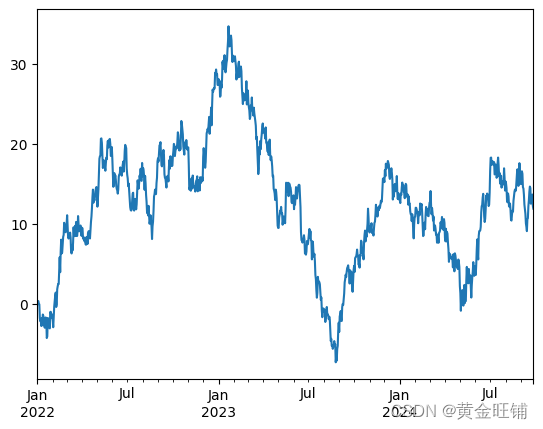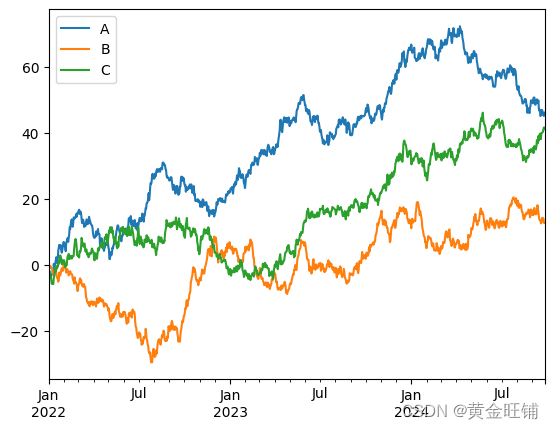【pandas】用户手册:10分钟熟悉pandas(下)
数据分组
Splitting: 利用某些条件将数据进行分组Applying: 函数应用于每个单独的分组Combining: 合并最终的结果
df = pd.DataFrame(
{
"A": ["foo", "bar", "foo", "bar", "foo", "bar", "foo", "foo"],
"B": ["one", "one", "two", "three", "two", "two", "one", "three"],
"C": np.random.randn(8),
"D": np.random.randn(8),
}
)
df
A B C D
0 foo one -0.738005 -2.019732
1 bar one 0.887627 0.015670
2 foo two -0.108933 -0.077614
3 bar three 0.076641 1.675694
4 foo two -0.787585 0.466678
5 bar two 0.193921 -0.345819
6 foo one 0.846988 -1.513333
7 foo three 1.110915 0.189766
df.groupby("A")[["C", "D"]].sum()
C D
A
bar 1.158189 1.345545
foo 0.323379 -2.954235
分组并应用
sum()对他们进行求和汇总
df.groupby(["A", "B"]).sum()
C D
A B
bar one 0.887627 0.015670
three 0.076641 1.675694
two 0.193921 -0.345819
foo one 0.108983 -3.533064
three 1.110915 0.189766
two -0.896518 0.389064
先对
A分组,后对B分组
df.groupby(["B", "A"]).sum()
C D
B A
one bar 0.887627 0.015670
foo 0.108983 -3.533064
three bar 0.076641 1.675694
foo 1.110915 0.189766
two bar 0.193921 -0.345819
foo -0.896518 0.389064
先对
B分组,后对A分组
注意:对多个列进行操作,用
[["C", "D"]]
对一个列进行操作,可以用["C"], 当然也可以用[["C"]]
数据表格形状改变
Stack
tuples = list(
zip(
["bar", "bar", "baz", "baz", "foo", "foo", "qux", "qux"],
["one", "two", "one", "two", "one", "two", "one", "two"],
)
)
# tuples
# 多索引值
index = pd.MultiIndex.from_tuples(tuples, names=["first", "second"])
df = pd.DataFrame(np.random.randn(8, 3), columns=["C1", "C2", "C3"], index=index)
df2 = df[:5]
df2
C1 C2 C3
first second
bar one -1.347431 0.153681 -1.006217
two -0.741849 -0.117988 -0.593601
baz one 0.394623 -0.360702 0.062728
two -0.477569 -1.504717 0.124419
foo one 0.340487 -1.045430 -0.623986
stacked = df2.stack()
stacked
first second
bar one C1 -1.347431
C2 0.153681
C3 -1.006217
two C1 -0.741849
C2 -0.117988
C3 -0.593601
baz one C1 0.394623
C2 -0.360702
C3 0.062728
two C1 -0.477569
C2 -1.504717
C3 0.124419
foo one C1 0.340487
C2 -1.045430
C3 -0.623986
dtype: float64
stack将数据压缩成一个列
上面例子中df2的shape为(5,3)
stacked的shape为(15, )
Pivot
创建一个电子表格风格的数据透视表作为数据框架。
函数原型:pandas.pivot_table(data, values=None, index=None, columns=None, aggfunc='mean', fill_value=None, margins=False, dropna=True, margins_name='All', observed=False, sort=True)
df = pd.DataFrame(
{
"C1": ["one", "one", "two", "three"] * 3,
"C2": ["A", "B", "C"] * 4,
"C3": ["foo", "foo", "foo", "bar", "bar", "bar"] * 2,
"C4": np.random.randn(12),
"C5": np.random.randn(12),
}
)
df
C1 C2 C3 C4 C5
0 one A foo -0.111176 -0.049645
1 one B foo -0.483144 -2.182207
2 two C foo 0.841522 -0.669410
3 three A bar 1.074447 -1.335228
4 one B bar -1.949381 0.594608
5 one C bar -1.544474 -0.873641
6 two A foo -0.837036 -1.054699
7 three B foo 0.537476 -0.359334
8 one C foo 0.169522 -1.594076
9 one A bar -0.595527 0.225416
10 two B bar -0.443136 -1.495795
11 three C bar -0.081103 1.551327
取
C1列的值作为新的label
取C2,C3列的值作为索引
取C5列的值作为表里的值, 无值则补NaN
pd.pivot_table(df, values="C5", index=["C2", "C3"], columns=["C1"])
C1 one three two
C2 C3
A bar 0.225416 -1.335228 NaN
foo -0.049645 NaN -1.054699
B bar 0.594608 NaN -1.495795
foo -2.182207 -0.359334 NaN
C bar -0.873641 1.551327 NaN
foo -1.594076 NaN -0.669410
时间序列
pandas 具有简单、强大、高效的功能,可以在变频过程中进行重采样操作(如将秒级数据转换为5分钟级数据)。这在(但不限于)金融应用程序中非常常见。请参阅时间序列部分。
rng = pd.date_range("1/1/2023", periods=100, freq="S")
ts = pd.Series(np.random.randint(0, 500, len(rng)), index=rng)
ts
2023-01-01 00:00:00 194
2023-01-01 00:00:01 306
2023-01-01 00:00:02 54
2023-01-01 00:00:03 198
2023-01-01 00:00:04 368
...
2023-01-01 00:01:35 431
2023-01-01 00:01:36 276
2023-01-01 00:01:37 286
2023-01-01 00:01:38 223
2023-01-01 00:01:39 217
Freq: S, Length: 100, dtype: int32
ts.resample("5Min").sum()
2023-01-01 25350
Freq: 5T, dtype: int32
Series.tz_localize() localizes a time series to a time zone:
将时间序列化为本地化一个时区
rng = pd.date_range("1/6/2023 00:00", periods=5, freq="D")
ts = pd.Series(np.random.randn(len(rng)), rng)
ts_utc = ts.tz_localize('UTC')
ts_utc
2023-01-06 00:00:00+00:00 0.418221
2023-01-07 00:00:00+00:00 -1.714893
2023-01-08 00:00:00+00:00 -0.464742
2023-01-09 00:00:00+00:00 0.005428
2023-01-10 00:00:00+00:00 0.209386
Freq: D, dtype: float64
将一个时区转到另外一个时区
ts_utc.tz_convert("US/Eastern")
2023-01-05 19:00:00-05:00 0.418221
2023-01-06 19:00:00-05:00 -1.714893
2023-01-07 19:00:00-05:00 -0.464742
2023-01-08 19:00:00-05:00 0.005428
2023-01-09 19:00:00-05:00 0.209386
Freq: D, dtype: float64
数据分类
df["raw_grade"].astype("category")将raw_grade类型换成了类别。
df = pd.DataFrame(
{"id": [1, 2, 3, 4, 5, 6], "raw_grade": ["a", "b", "b", "a", "a", "e"]}
)
df["grade"] = df["raw_grade"].astype("category")
df["grade"]
0 a
1 b
2 b
3 a
4 a
5 e
Name: grade, dtype: category
Categories (3, object): ['a', 'b', 'e']
rename_categories将类别名称重命名。
new_categories = ["very good", "good", "very bad"]
df["grade"] = df["grade"].cat.rename_categories(new_categories)
df["grade"]
0 very good
1 good
2 good
3 very good
4 very good
5 very bad
Name: grade, dtype: category
Categories (3, object): ['very good', 'good', 'very bad']
增加新的类别
df["grade"] = df["grade"].c> `df["raw_grade"].astype("category")` 将`raw_grade`类型换成了类别。at.set_categories(
["very bad", "bad", "medium", "good", "very good"]
)
df["grade"]
0 very good
1 good
2 good
3 very good
4 very good
5 very bad
Name: grade, dtype: category
Categories (5, object): ['very bad', 'bad', 'medium', 'good', 'very good']
显示数据
import matplotlib.pyplot as plt
plt.close("all")
ts = pd.Series(np.random.randn(1000), index=pd.date_range("1/1/2022", periods=1000))
ts = ts.cumsum()
ts.plot()

df = pd.DataFrame(np.random.randn(1000, 3), index=ts.index, columns=['A', 'B', 'C'])
df = df.cumsum()
plt.figure()
df.plot()
plt.legend(loc='best')

数据导入导出
CSV
df.to_csv("foo.csv")
pd.read_csv("foo.csv")
Unnamed: 0 A B C
0 2022-01-01 -2.112172 -0.161145 -1.891843
1 2022-01-02 -1.787807 -0.469220 -1.592460
2 2022-01-03 -2.366840 -0.465609 -3.204489
3 2022-01-04 -2.913202 -0.220295 -3.415782
4 2022-01-05 -3.819952 -0.831654 -3.465468
.. ... ... ... ...
995 2024-09-22 45.661361 13.760668 40.401864
996 2024-09-23 45.608082 14.161003 41.035935
997 2024-09-24 45.256665 12.934910 41.751221
998 2024-09-25 46.313781 12.783737 41.720967
999 2024-09-26 46.183519 12.790855 41.323802
[1000 rows x 4 columns]
HDF5
df.to_hdf("foo.h5", "df")
pd.read_hdf("foo.h5", "df")
这中间有可能会报错:
File d:\Anaconda3\envs\pytorch\lib\site-packages\pandas\compat\_optional.py:141, in import_optional_dependency(name, extra, errors, min_version)
140 try:
--> 141 module = importlib.import_module(name)
142 except ImportError:
File d:\Anaconda3\envs\pytorch\lib\importlib\__init__.py:127, in import_module(name, package)
126 level += 1
--> 127 return _bootstrap._gcd_import(name[level:], package, level)
File <frozen importlib._bootstrap>:1014, in _gcd_import(name, package, level)
File <frozen importlib._bootstrap>:991, in _find_and_load(name, import_)
File <frozen importlib._bootstrap>:973, in _find_and_load_unlocked(name, import_)
ModuleNotFoundError: No module named 'tables'
During handling of the above exception, another exception occurred:
ImportError Traceback (most recent call last)
Cell In [90], line 1
----> 1 df.to_hdf("foo.h5", "df")
...
--> 144 raise ImportError(msg)
145 else:
146 return None
ImportError: Missing optional dependency 'pytables'. Use pip or conda to install pytables.
提示用
pip install pytables但还是会报错,最后改用pip install tables解决问题;
`ERROR: Could not find a version that satisfies the requirement pytables (from versions: none)
ERROR: No matching distribution found for pytables
A B C
2022-01-01 -2.112172 -0.161145 -1.891843
2022-01-02 -1.787807 -0.469220 -1.592460
2022-01-03 -2.366840 -0.465609 -3.204489
2022-01-04 -2.913202 -0.220295 -3.415782
2022-01-05 -3.819952 -0.831654 -3.465468
... ... ... ...
2024-09-22 45.661361 13.760668 40.401864
2024-09-23 45.608082 14.161003 41.035935
2024-09-24 45.256665 12.934910 41.751221
2024-09-25 46.313781 12.783737 41.720967
2024-09-26 46.183519 12.790855 41.323802
[1000 rows x 3 columns]
excel
ModuleNotFoundError: No module named 'openpyxl'
# pip install openpyxl
df.to_excel("foo.xlsx", sheet_name="Sheet1")
pd.read_excel("foo.xlsx", "Sheet1", index_col=None, na_values=["NA"])
Unnamed: 0 A B C
0 2022-01-01 -2.112172 -0.161145 -1.891843
1 2022-01-02 -1.787807 -0.469220 -1.592460
2 2022-01-03 -2.366840 -0.465609 -3.204489
3 2022-01-04 -2.913202 -0.220295 -3.415782
4 2022-01-05 -3.819952 -0.831654 -3.465468
.. ... ... ... ...
995 2024-09-22 45.661361 13.760668 40.401864
996 2024-09-23 45.608082 14.161003 41.035935
997 2024-09-24 45.256665 12.934910 41.751221
998 2024-09-25 46.313781 12.783737 41.720967
999 2024-09-26 46.183519 12.790855 41.323802
[1000 rows x 4 columns]
【参考】
10 minutes to pandas — pandas 1.5.2 documentation (pydata.org)
相关文章
- Py之pandas:字典格式数据与dataframe格式数据相互转换并导出到csv
- 100天精通Python(数据分析篇)——第70天:Pandas常用排序、排名方法(sort_index、sort_values、rank)
- python pandas自定义函数之apply函数用法
- Pandas 横向合并DataFrame数据
- Python数据科学pandas终极指南【看这篇文章就够了】
- pandas入门10分钟——serries其实就是data frame的一列数据
- Pandas学习导图
- 数据分析工具Pandas基础 数据清洗--处理缺失数据、处理重复数据、替换数据处理
- 如何在 Pandas DataFrame 列中搜索值?
- pandas多键值merge

